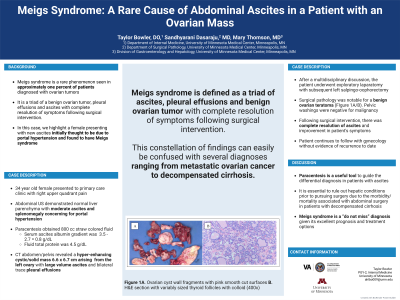Monday Poster Session
Category: Liver
P2992 - Meigs Syndrome: A Rare Cause of Abdominal Ascites in a Patient With an Ovarian Mass
Monday, October 28, 2024
10:30 AM - 4:00 PM ET
Location: Exhibit Hall E

Has Audio

Taylor Bowler, DO
University of Minnesota Medical Center
Minneapolis, MN
Presenting Author(s)
Taylor Bowler, DO, Sandhyarani Dasaraju, MD, Mary Thomson, MD, MSc
University of Minnesota Medical Center, Minneapolis, MN
Introduction: Meigs syndrome is a triad of a benign ovarian tumor, pleural effusions and ascites with resolution of symptoms following surgical intervention. This constellation of findings can easily be confused with several diagnoses ranging from metastatic ovarian cancer to decompensated cirrhosis. In this case, we highlight a 34-year-old female presenting with abdominal pain and new ascites initially concerning for decompensated cirrhosis, who was subsequently found to have an atypical presentation of Meigs syndrome in the setting of a benign ovarian teratoma.
Case Description/Methods: A 34-year-old female presented to her primary care physician for right upper quadrant pain. An initial work-up was unremarkable including normal complete blood count, liver function and coagulation tests. Viral hepatitis panel and lipase were normal. An ultrasound demonstrated normal parenchyma of the liver, but showed moderate ascites with borderline splenomegaly suspicious for portal hypertension. Given the inconsistency between laboratory and imaging findings, an MRI elastography was pursued. The liver was normal in morphology and the average liver stiffness was 295 kPa compatible with borderline stage 1-2 fibrosis. She was referred to hepatology who recommended a paracentesis for further evaluation. The serum ascites albumin gradient (SAAG) was low at 0.8 g/dL, making portal hypertension less likely. Fluid total protein was elevated at 4.5 g/dL. Total cell count was 114 (12% neutrophils). Fluid triglyceride level was 16 mg/dL and lactate dehydrogenase was 94 mg/dL. Cytology was negative for malignancy. CT imaging was pursued to evaluate for peritoneal malignancy causing low SAAG and high protein ascites. Imaging showed a hyperenhancing cystic and solid mass measuring 6.6 x 6.7 cm on the left ovary, large volume ascites and trace pleural effusions. The patient was referred to gynecology oncology for laparoscopy. Surgical pathology showed a benign ovarian teratoma, struma ovarii (Figure 1). Following surgery, there was resolution of ascites with improvement in the patient’s symptoms. She was discharged from hepatology and follows with gynecology for routine care without evidence of recurrent ascites or ovarian pathology.
Discussion: This case highlights an atypical presentation of Meigs syndrome from an ovarian teratoma. This rare phenomenon should be considered when evaluating females with ascites to prevent misdiagnosis and offer treatment that effectively resolves their symptoms.

Disclosures:
Taylor Bowler, DO, Sandhyarani Dasaraju, MD, Mary Thomson, MD, MSc. P2992 - Meigs Syndrome: A Rare Cause of Abdominal Ascites in a Patient With an Ovarian Mass, ACG 2024 Annual Scientific Meeting Abstracts. Philadelphia, PA: American College of Gastroenterology.
University of Minnesota Medical Center, Minneapolis, MN
Introduction: Meigs syndrome is a triad of a benign ovarian tumor, pleural effusions and ascites with resolution of symptoms following surgical intervention. This constellation of findings can easily be confused with several diagnoses ranging from metastatic ovarian cancer to decompensated cirrhosis. In this case, we highlight a 34-year-old female presenting with abdominal pain and new ascites initially concerning for decompensated cirrhosis, who was subsequently found to have an atypical presentation of Meigs syndrome in the setting of a benign ovarian teratoma.
Case Description/Methods: A 34-year-old female presented to her primary care physician for right upper quadrant pain. An initial work-up was unremarkable including normal complete blood count, liver function and coagulation tests. Viral hepatitis panel and lipase were normal. An ultrasound demonstrated normal parenchyma of the liver, but showed moderate ascites with borderline splenomegaly suspicious for portal hypertension. Given the inconsistency between laboratory and imaging findings, an MRI elastography was pursued. The liver was normal in morphology and the average liver stiffness was 295 kPa compatible with borderline stage 1-2 fibrosis. She was referred to hepatology who recommended a paracentesis for further evaluation. The serum ascites albumin gradient (SAAG) was low at 0.8 g/dL, making portal hypertension less likely. Fluid total protein was elevated at 4.5 g/dL. Total cell count was 114 (12% neutrophils). Fluid triglyceride level was 16 mg/dL and lactate dehydrogenase was 94 mg/dL. Cytology was negative for malignancy. CT imaging was pursued to evaluate for peritoneal malignancy causing low SAAG and high protein ascites. Imaging showed a hyperenhancing cystic and solid mass measuring 6.6 x 6.7 cm on the left ovary, large volume ascites and trace pleural effusions. The patient was referred to gynecology oncology for laparoscopy. Surgical pathology showed a benign ovarian teratoma, struma ovarii (Figure 1). Following surgery, there was resolution of ascites with improvement in the patient’s symptoms. She was discharged from hepatology and follows with gynecology for routine care without evidence of recurrent ascites or ovarian pathology.
Discussion: This case highlights an atypical presentation of Meigs syndrome from an ovarian teratoma. This rare phenomenon should be considered when evaluating females with ascites to prevent misdiagnosis and offer treatment that effectively resolves their symptoms.

Figure: Figure 1A. Ovarian cyst wall fragments with pink smooth cut surfaces. 1B. H&E section with variably sized thyroid follicles with colloid (400x).
Disclosures:
Taylor Bowler indicated no relevant financial relationships.
Sandhyarani Dasaraju indicated no relevant financial relationships.
Mary Thomson indicated no relevant financial relationships.
Taylor Bowler, DO, Sandhyarani Dasaraju, MD, Mary Thomson, MD, MSc. P2992 - Meigs Syndrome: A Rare Cause of Abdominal Ascites in a Patient With an Ovarian Mass, ACG 2024 Annual Scientific Meeting Abstracts. Philadelphia, PA: American College of Gastroenterology.
